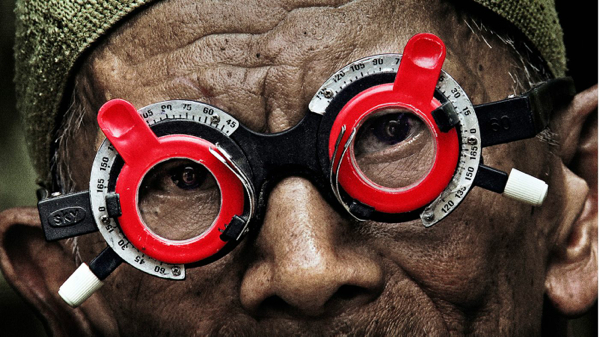Movie review by Greg Carlson
With “The Look of Silence,” filmmaker Joshua Oppenheimer and his dedicated collaborators have constructed a harrowing companion piece to the unforgettable chronicle of genocide in Indonesia depicted in “The Act of Killing.” In one sense answering critics who wondered why the prior film concentrated on the perpetrators of murder and not on the victims, “The Look of Silence” follows the stygian odyssey of Adi Rukun, whose brother was brutally dispatched by locals so completely deaf to their crimes they enthusiastically recount the grisly details on camera without any sense of guilt or remorse.
The 44-year-old Adi is an optometrist by profession, and several of the movie’s interactions unfold during eye examinations performed on the anti-communist constituents of the movement that eventually replaced the Sukarno presidency with the Suharto regime. Both of Oppenheimer’s projects feature the surreal, dispassionate spectacle of men willing to share the grotesque nuts and bolts of their personal experiences as vigilante participants, and some of the most painful and moving scenes in “The Look of Silence” show Adi as he impassively processes firsthand accounts of disembowelment, genital mutilation, and even the ingestion of the blood of the condemned.
Several of the discussions on the ethical responsibilities of documentarians begun when “The Act of Killing” was released are being revisited by cinephiles eager to process the extremely difficult intellectual terrain explored by Oppenheimer. Unflinching and unapologetic as ever, Oppenheimer’s practice of getting close to the guilty can result in some queasy confrontations when Adi shines light on his brother’s murder in the presence of the complicit. Additionally, Oppenheimer uses Adi’s century old, skeletal father – mostly blind and deaf – as a kind of emblem of vulnerability. In one scene, the terrified, disoriented elder crawls around his room, convinced he has somehow ended up in a stranger’s house.
Like “The Act of Killing,” this film raises questions about the safety of its participants, and one almost immediately begins to worry for Adi as he and Oppenheimer record conversations with people who have, in a stranger-than-fiction set of circumstances, benefited and profited from their roles as executioners. Adi’s willingness to face these butchers could be many things – brave, dangerous, possibly foolish – but to him it is clearly necessary. The various responses we hear are the stuff of nightmare, and yet another film could be made from the extent to which the United States directly and indirectly supported the death squads.
The most rewarding dimension of “The Look of Silence” can be discovered in Adi’s quiet patience and external placidity. One would expect that Adi would on some level be seeking a measure of revenge or retribution for the evil perpetrated against his family, but Oppenheimer makes clear the monumental denial that places something resembling justice far out of the reach of the Indonesians persecuted by their own fellow citizens. The 1965-1966 timeframe of the massacres is not that long ago, and by far the most frightening realization embedded in both “The Act of Killing” and “The Look of Silence” is the possibility that something like this could so easily happen again, and happen anywhere.
